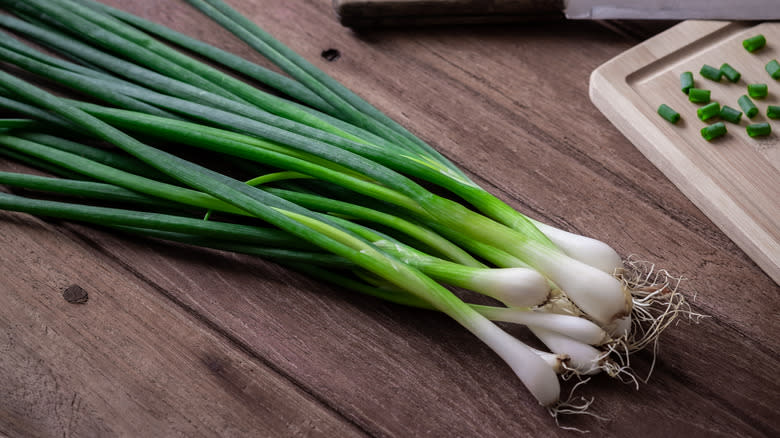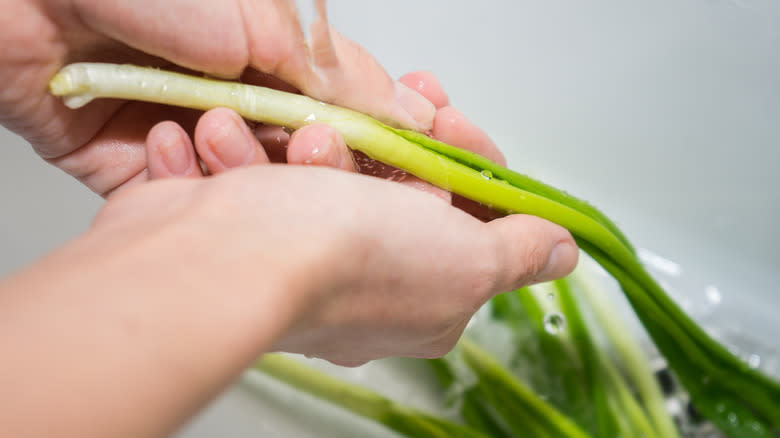This Simple Mistake Is Ruining Your Green Onions

Everyone's experienced the disappointment of storing vegetables in the fridge for a later recipe, only to forget they were there until you find them rotting in the bottom of a drawer. Green onions, also known as scallions even though they have a few differences, are the prime culprit of this because of this one mistake you're probably making: Washing them before you refrigerate them.
It may be instinct to wash your produce before storing it — especially if you're a fan of those fridge restock videos where each item is washed and placed in an organized container — but washing your green onions is actually a disadvantage. Green onions spoil from too much moisture, so by washing them ahead of time, you overload them with water, which makes them get mushier faster. Instead, wait until just before using them to give them a thorough rinse to make sure they're fresh, crunchy, and ready to use in a recipe or as a tasty garnish.
Read more: 12 Vegetables And Fruits That Used To Look Very Different
Don't Waterlog Your Green Onions

Too much water will certainly ruin your green onions, but on the other hand, nobody likes a dry vegetable, so it's all about finding a delicate balance. When you wash your green onions before storing them, you essentially prepare them for cooking and then delay all your work — this means your onions will spoil more quickly because you've taken away all their outer defenses and filled them with water. However, this doesn't mean you should just chuck your scallions straight into the fridge right after buying them — that's another one of the mistakes you might be making with your onions.
Scallions are often sold in bunches, and when shopping for them, it's best to look for the bunches that look more under-ripe, meaning they're less wilted and have the lightest green leaves. Before storing them, remove the rubber band that holds them together — which actually can trap moisture — and lay the scallions out on a dry paper towel without washing them beforehand. Roll the paper towel up loosely so the green onions form a bundle, then store the whole bundle in a tightly sealed, air-compressed plastic bag. The dry paper towels will keep your scallions from molding, but sealing them in the plastic bag will trap the existing moisture, creating a perfectly balanced environment. Once you've sealed them in the plastic bag, you can keep them fresh in the fridge for up to three weeks if saving them for a later recipe.
Mistakes To Avoid When Storing Green Onions

Of course, there are all manner of storage method hacks for green onions that may seem effective, but actually spoil your produce quicker. The first mistake to avoid is freezing your green onions. This is a guaranteed moisture trap that, especially when thawed, will lead to your scallions becoming mushy and damp. Note that it is okay to store scallions in the freezer if they are already in a prepared dish, but fresh green onions are best kept in the fridge.
Another popular storage method for green onions is in a glass or mason jar filled with enough water to cover the white part of the scallions. This is meant to keep them fresh and simulate a growing environment, but it can be an impractical way to store them. What often happens is the onions will start to sprout — which, if that's the goal, then job well done — but this doesn't make the onion suitable for cooking and may leave you wondering if it's safe to eat sprouted onions. Additionally, if you leave the scallions in the water for more than a day or two, they can start to wilt just like flowers do in a vase. In essence, this hack is more for show and doesn't do as much to preserve the freshness of your green onions. So next time you pick up green onions from the store, remember to skip the water until it's time to put those veggies to use.
Read the original article on The Daily Meal.


